Like most people, I like and embrace the outdoors as much as I can, taking treks when I’m in the mountains, surfing when there’s waves at the beach (which is where I spend most of my free time) or looking for something to do that involves being active. Yet for a few months now a new challenge that I had never considered has been running around in my head: high altitude mountain climbing. Yup, I’ve been wanting to climb one of those high mountains where there’s perpetual snow at the top needing crampons just to get around, and even breathing is a challenge because of the lack of oxygen, and I recently had the opportunity to participate in such an adventure. I certainly got more than what I bargained for as it has been the toughest physical challenge I’ve done in my life (remember that half marathon I ran in sandals with the Raramuri ? I now laugh about it) and well, by the time you finish reading this one person will have died.
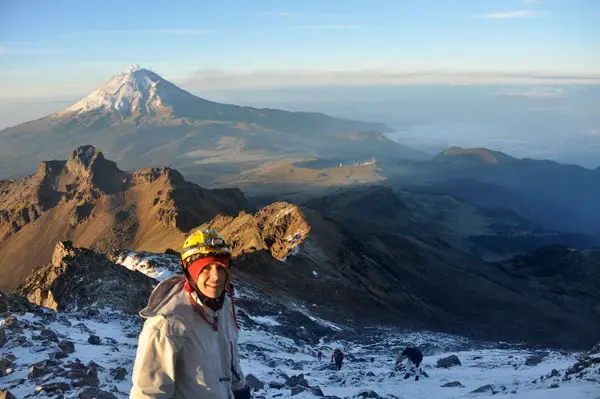
The Challenge: Mt Iztacciuhuatl at 5,200 m (around 17,200 ft)
You’ll probably be surprised to learn that Mexico is not all about beaches and diving, or maybe even jungle trekking. There’s also some pretty tall mountains and active volcanoes, a great playground for those who are passionate of being above the clouds without the need of a flying machine. The tallest mountain in Mexico is Mt Orizaba which is also the fourth highest peak in North America at around 5,700 m ( around 18,000 ft), followed by active volcano Mt Popocateptl and then by my first high altitude objective, Mt Iztaccihuatl at around 5,200 m. I wasn’t aware that my pick is the most demanding technically even if not the highest, and for this I would pay a price I wasn’t expecting to.
Preparing for the Climb
High altitude climbing and trekking is no walk in the part and certainly not for anyone to give it a shot. You need to be in decent physical condition and be prepared to find breathing a difficulty in itself, perhaps the toughest aspect of it all as it’s something you can’t really feel you’re improving at. Your body will decide for you if it can tackle or not what you’re putting it through: altitude sickness can start as low as 2,500 m , and if it happens, the individual should head back down as soon as possible because severe altitude sickness can ultimately lead to death.
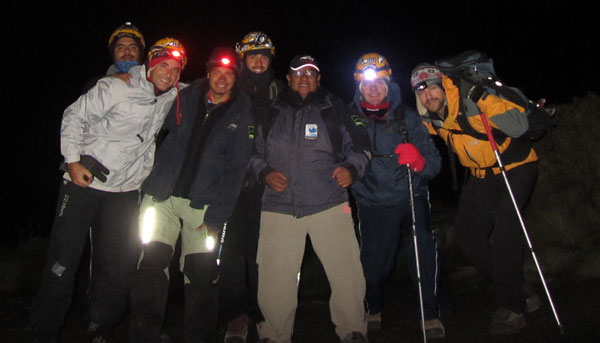
Living by the ocean I believed that the altitude would be my toughest challenge, though I relied on the fact that I practically ran up Mt Fuji in Japan a few years ago and had been in the Andes before then at around 6,000 m to believe that it is something I could do. I was also aware that I needed professional gear and expertise to make this adventure a reality and I contacted HG Mexico ,a high altitude mountain guide operator based in Mexico I found online which appeared to be very professional and experienced in the field. After some tips and guidance from Guillermo (the manager) we decided on a day to make this happen: a little over two weeks after that phone call. HG Mexico would provide all the mountain gear needed (they do so with everyone who needs it at no extra cost) and I simply needed to be there as agreed.
During those two weeks I was very busy with work, but I tried to squeeze in a few long(er) runs and tried to work out my legs for that extra power. I also spoke with Luis, my brother in-law who I convinced to join me as he’s also an outdoors enthusiast, with a few marathons under his belt. I hoped that by arriving one day early to Mexico City (2,400 m)and walking around my acclimatization would be enough, and I was lucky enough to stay at Hotel Geneve, a great hotel with lots of history that would allow me to rest and spend some quality time preparing for my adventure.
Climbing Mt Iztazzihuatl: Initial Hours
At around 1 pm on Saturday Guillermo and his team came to pick us up with the van and all the gear at the hotel, and from there we drove for two hours to the mountain. It was interesting how it didn’t really look that high from the town at its base, perhaps because we were already at 3,000 meters by then. The road then meanders uphill to a restaurant for tourists who want to get a bit closer and there’s a 15 minute trail after that that ends where the TV and cell phone antennas are, as well as the first base camp with a refuge at 3,900 m. Once there we pulled out all our gear and were given some technical lessons on how to use and wear crampons, how to walk with them on the snow, what to do with the piolet if you fall and slide downhill and more. We then had an early dinner and headed off to the bunk beds where we’d doze for a few hours before starting the climb at 2 am. In case you were not aware summiting any mountain usually takes place during sunrise, when the wind hasn’t yet started.
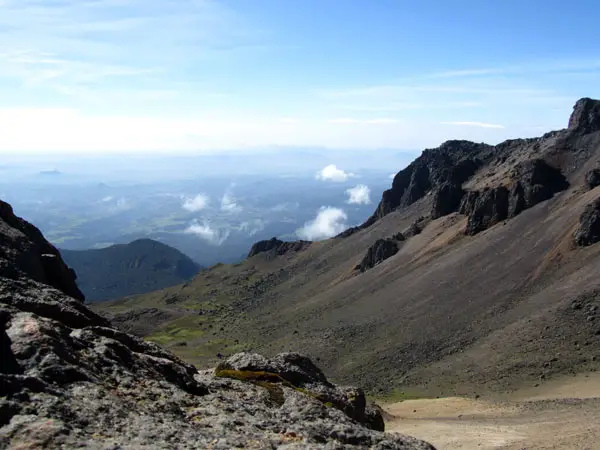
Shortly after we got into our bunk beds a group of around 17 people arrived to the refuge, noisily and I suppose excited about what they were about to do. We later learned that the leader of the group was an amateur climber who walked around in a sleeveless t-shirt despite the almost freezing temperatures. The group unpacked its gear, cooked a simple dinner and left shortly after.
The Climb
At around 2 pm we were awakened ( truth is I already had a headache because of the altitude and had not slept at all), we got all our gear (I had the DSLR camera, a P&S camera, the crampons, 2 liters of water , some food, wind goggles and some extra clothes. It wasn’t particularly cold (about 4 Celsius) and we made our way to the beginning of the trail. After some pictures and high spirit remarks the first guide led the way uphill into the night, with Luis, myself and two more climbers following him, and a second guide closing the group.
It was just the beginning, and we were walking fast. Really fast. Just a few minutes into it and I was already panting, breathing heavily as we made our way up the mountain. I was very surprised about this speed, already wondering if I would be able to keep up the full 14 hours the climb as supposed to last.
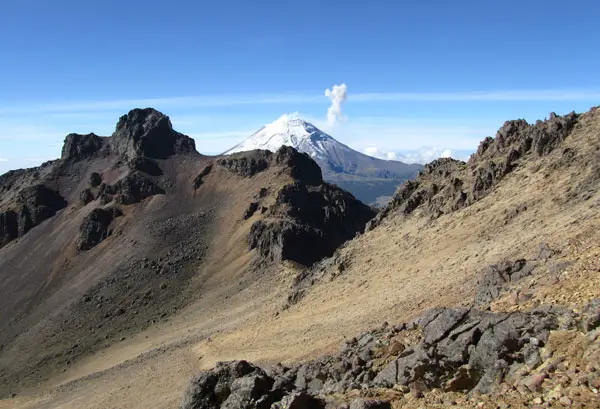
Fifteen minutes later we took a break, and the guide told us that we had just “run the mountain”, meaning that he had done this to get our heart rate up and prepare for what was to come, both physically and mentally. The climb continued, a bit slower, but nonetheless being a challenge already. I could already feel why altitude could be a problem, and the breaks were becoming more frequent- and necessary. Just three hours later and lots of effort we caught up with the group that had left the refuge earlier; apparently they were lost and did not know which way to go. After out guides gave them some pointers we passed them and continued our way, I being very tired, having difficulty breathing and beginning to wonder what I had gotten myself into. After another hour of strenuous walking we reached the second and last refuge, with the first rays of light still not showing up. At this point we were told to eat something, drink as much as we could, and try to get as much oxygen during the break which was not easy at 4,500 m. Breathing was already very difficult for me, I was shivering without it being too cold, and it was then that I began to wonder if I would summit.
Close, But No Cigar
About 45 minutes after leaving refuge number two the first light of the day appeared and by the time I noticed again I didn’t even need the headlamp any more. A few minutes ago we’d been told to put the crampons on ( I was exhausted, just putting them on was a tremendous effort) and it was then that I first looked back to look at the surroundings. It was breathtaking. The sky had an orange hue, everything was still, there were mountains and clouds down below, and all you I could hear was myself trying to breathe. I asked the guide that was with me ( I was last in the group, the rest about 20 m ahead of me) what altitude we were at as I was beginning to think about quitting ( I still had to walk 6 hours back) and when the guide told me we were at 4,900 m I began to think there was a chance I could summit.
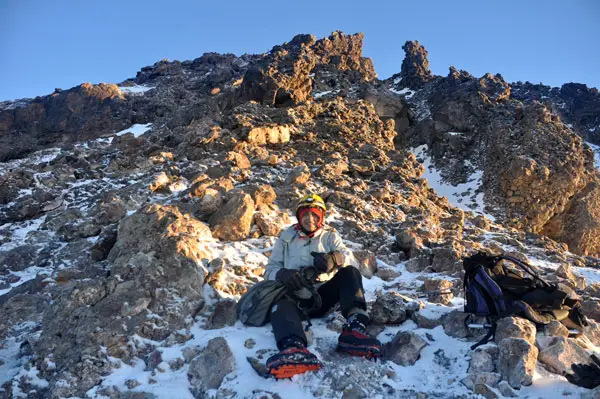
“So the summit is up there, behind those rocks?” I asked pointing at some snow covered rocks, so close, yet so far away.
“Unfortunatelly not. “ he said. “ Up there you reach a plateau at 5,190m, but then you have to walk about 3 hours to where the real summit is. But you can do it!”
I weighed my options. Every step meant taking a 10 second break, it would take me forever to reach the summit, if I did. And I then had to get back, and there’s no helicopters should we run into trouble.
“Tell you what. Shoot for that cross up there, it marks the 5,000m point”. It seemed so far away, but I decided to do that. Heading up was a huge effort, and it was when I pulled myself up a rock that I noticed I could barely hold on to myself (something I can easily do under normal conditions) that summiting was no longer an option. I reached the cross, exhausted, tired, upset because I wouldn’t summit, but glad that I at least reached the 5,000 meter mark. On my left was Popocatepl volcano, with smoke coming from the top, the clouds below me and the base camp way down there. An unreal moment, yet difficult to value because of how exhausted I was.
The Way Back
A few minutes later I began my descent, which ended up being long, exhausting ,never-ending and even annoying. I was too tired to fully appreciate the beauty around me but I did remember to take a few pictures along the way, though way less than what I’d planned to. It took me almost 5 hours to reach the base camp again, with a couple of long stops along the way to get some air and rest and helping another exhausted climber find the correct route back down. The lack of oxygen had been my Damocles sword, and it had beat me. Once I reached base camp I got rid of my gear and got into the van to lie down and rest.
A few minutes after getting into the van I noticed there was some unusual movement around me, with what appeared to be a rescue team asking questions. The guides in my group were the only ones with radio, and Guillermo, the leader, had been told that somebody had fallen and had cracked his head open. After some technical problems Guillermo was able to acertain that the individual was not in our group, that the rest of the group had barely managed to summit but had succeeded, and were all on their way back.
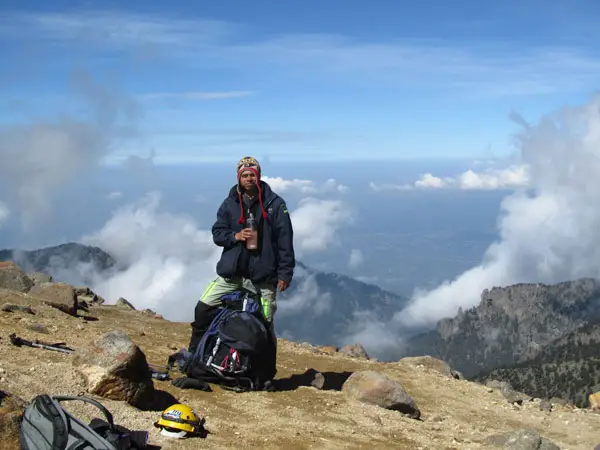
The first person to arrive was the only non-guide member of our group who had mountain experience, and had further information about the accident as he had seen, from afar, where the person was and had spotted someone who was trying to reach him. He had been too tired to be able to help, but after speaking with other climbers had ascertained that it was the sleeveless t-shirt leader we’d seen the night before, who was attempting the summit without a helmet or crampons. How foolish of him. He had slipped on an ice patch and had rolled down the face about 200 meters hitting his head on several rocks along the way. It would take the rescue team at least 5 hours to get there, and with an open skull and a lack of oxygen they would most probably find a cadaver. We never found out what happened to him but the guides were convinced about the worst.
Within the next hour and a half the remaining three members of the group arrived, exhausted too and surprised at how long and difficult the way down had been. I also learned that one of the other three members had not wanted to summit because of exhaustion, but if he didn’t continue the other two would not have been able to either because there was only one guide with them. He didn’t remember anything about the summit (he’d been too tired) and, to him, the extra effort had not been worth it. But for them the feeling of accomplishment was there, and I, well, I had reached the 5000 m mark, and had experienced that biggest altitude change (full on 5,000m, unlike them as they had experienced 2,500m). I had pushed myself to limits I had never reached before and stopping where I did had been a good decision.
Conclusion and Tips
As we made our way back to Mexico City we slowly began to recover, and talk about what we had all just gone through. We were all surprised at how tough it had been and all agreed that it was the toughest thing we had ever done in our lives. Luis (my in-law) confessed that when heading to the summit he’d been grumpy about what I had gotten him into, and I also learned that nobody who lives by the ocean- not even professional climbers- had ever summited Mt Iztaccihuatl without at least 4 days of altitude acclimatization.
The “never again” phrase we’d been repeating all the time for the past few hours was began to dwindle, and the reality of the adventure we’d just been through began to sink it. Attempting these things is not just about climbing a mountain, but about pushing your limits to what you didn’t think was possible. It’s about testing yourself, experiencing an adventure, and going to where not many people can or do.
This said, I can say I will attempt to summit again, but not the same mountain. My next adventure will probably take me to Mt Orizaba, 600 m higher, and this time I will train for a month and acclimatize to the altitude as much as I can a week before. Due date: Spring 2015.
Finally, I want to give a big thank you to HG Mexico, a company I cannot recommend enough. Friendly, very experienced and professional, I felt comfortable and safe at all times despite being in a challenging environment. They not only offer guided services to this mountain but other small ones too which are more accessible to recreational trekkers. You can arrange several guided tours with them with several options to include or disregard.
This adventure was possible thanks to HG Mexico who was happy to sponsor my trip. They’ve been the first company I ever work with for my first ever mountaineering climb and I’m not sure if they job can be done any better. Manager Guillermo is the former high mountain safety coordinator of Mexico, boasting more than 30 years of experience throughout the country. He’s also been invited to support climbing expeditions to Mt Everst, but has yet to accept one though he thinks he will. The team is friendly and amusing, all members know what they’re doing, and will encourage trekers to keep going, without being pushy. To contact them visit www.hgmexico.com, and tell them you learned about them via this website. I know I will be contacting them on my next expedition to Mt Orizaba.
Do you have any high altutude climbing experience? Is this a kind of adventure you would like to be part of? What mountain did you climb, or would you like to climb? If planning to climb this mountain feel free to ask in the comments section below, or send me an email! And if you think other may like to read about it, how about some social sharing?

Once upon a time this would have been a dream for me! Not so much any more. I’m happier to read from the sidelines…
I can’t blame you, it’s not a simple walk in the park!
What a climb! Even though you didn’t reach the summit, it’s still such an accomplishment to even get as far as you did! I’m sure you’ll conquer the next one =)
Challenging indeed, I do hope to succeed next time! It was a partial victory at least… 🙂
What a great adventure! Good luck with your training.
Hi Laura! It was an adventure indeed, let’s see how the next one goes!
“An unreal moment, yet difficult to value because of how exhausted I was.”
I felt precisely this way on a couple of treks I did in South America, particularly the 4-day classic Inca Trail to Machu Picchu. It wasn’t even the hardest trek I’d done at that point, but the weather had been awful so on top of being exhausted we were cold, wet, and maybe worst of all, hungry. Sometimes trips like this can only be appreciated in retrospect, I think! Amazing that you attempted something so challenging though, even if you didn’t make the summit it’s still quite an achievement if you ask me!
I fully agree with you. As I recently heard a professional mountaineer and adventurer say, 90% of the time your uncomfortable and wishing you were elsewhere. It’s the challenge of the unusual and atypical that calls us I’d say!
Climbing the 10 steps up a tiny hill at Everest Base Camp in Tibet practically killed me. I don’t think high altitude mountaineering is anywhere in our near future! Congrats on reaching the 5000m mark!!!
Everest BC is at 5300m…a challenge by itself already! I would like to make it there some day, but I’ve learned the hard way that I need to train…
Wow, that is quite the feat! We have dabbled in some trekking but nothing close to 14 hours! We plan on heading back to Nepal next year, perhaps we’ll look into some climbing there.
Nepal…I will make it there, eventually!